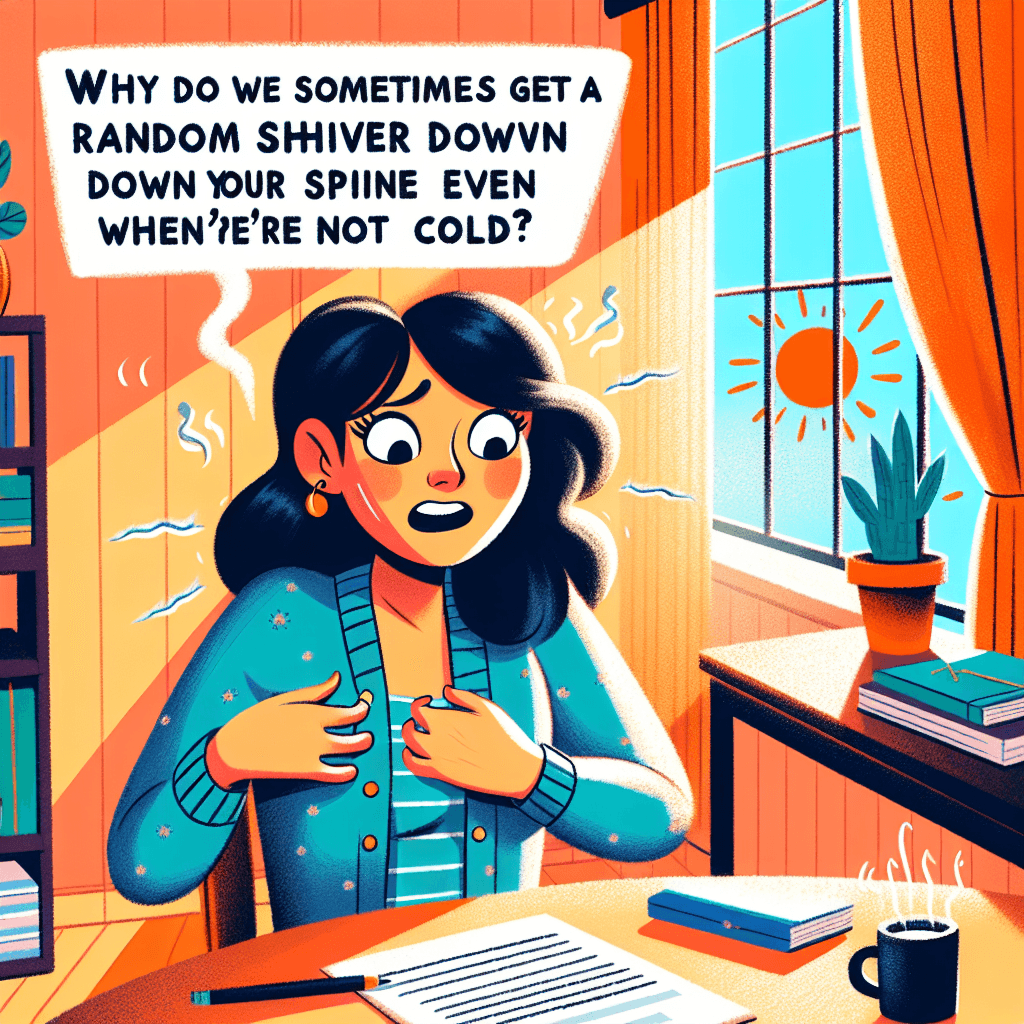Why do we sometimes get a random shiver down our spine even when we're not cold
That random shiver has nothing to do with the temperature; it’s a fascinating evolutionary echo that reveals how your brain is hardwired for intense emotion.


Too Long; Didn't Read
TLDR: Those random shivers are an evolutionary leftover, like goosebumps. When not caused by cold, they are a physical reaction to strong emotions like awe, fear, or powerful music, which can trigger a release of adrenaline.
Blog Post Title: Goosebumps on a Warm Day? Why We Get a Random Shiver Down Our Spine Even When We're Not Cold
You’re listening to a powerful piece of music, looking at a breathtaking piece of art, or recalling a poignant memory when it happens: a sudden, involuntary wave of goosebumps and a distinct shiver that travels right down your spine. But the room isn’t cold, and you’re not scared. This common yet curious human experience can feel mysterious, leaving many to wonder what’s happening inside their bodies. While we associate shivers with fending off a chill, these "emotional shivers" are a completely different phenomenon. This post will demystify this sensation, exploring the fascinating intersection of our evolutionary biology and complex emotional responses that causes a random shiver down our spine even when we're not cold.
It's Not Just You: Understanding Piloerection
At its core, the physical reaction of a shiver or goosebumps is called piloerection. This is an involuntary reflex where tiny muscles at the base of each hair follicle, known as arrector pili muscles, contract. This contraction causes your body hair to stand on end.
This mechanism is a fascinating holdover from our more hirsute ancestors. For them, piloerection served two key survival functions:
- Insulation: When an animal is cold, its hair standing on end traps a layer of air close to the skin, providing better insulation against the cold.
- Intimidation: When threatened, making their fur stand up made them appear larger and more intimidating to potential predators.
While modern humans don't have enough body hair for these effects to be practical, the underlying neural wiring remains. This system is controlled by the sympathetic nervous system, the same network responsible for our "fight-or-flight" response. This is the crucial link to understanding why emotions—not just temperature—can trigger this primal reaction.
The Power of Emotion: What is Frisson?
When a shiver is triggered by an emotional stimulus rather than a physical one, it's often referred to as frisson (pronounced free-sawn). The term is French for "aesthetic chills," and it's sometimes poetically described as a "skin orgasm" due to its intensely pleasurable, goosebump-inducing feeling.
Frisson is a psychophysiological response to stimuli that we find deeply moving or profound. Common triggers include:
- Music: A sudden change in volume, a soaring crescendo, or a particularly beautiful harmony.
- Visuals: A dramatic scene in a movie, a stunning landscape, or a powerful piece of art.
- Narrative: A touching story, a heroic act, or a profound speech.
- Memory: Recalling a significant personal event.
Research from institutions like McGill University has shown that experiencing frisson activates the same reward circuits in the brain that are stimulated by things like delicious food, winning money, or addictive substances. When you experience frisson, your brain releases a flood of dopamine—a neurotransmitter strongly associated with pleasure and motivation. This explains why, despite its connection to the "fight-or-flight" system, the sensation feels so good.
A Primal Response in a Modern World
So, how does a beautiful song trick our ancient survival wiring into action? The leading theory suggests it's a delightful neurological mix-up.
When we are exposed to a powerful and unexpected stimulus—like a sudden, loud swell in a symphony—our primitive brain might interpret it as a potential threat on a subconscious level. This briefly triggers the sympathetic nervous system, causing the piloerection and shiver.
However, almost instantly, our conscious, cognitive brain assesses the situation and recognizes there is no actual danger. It correctly identifies the source as non-threatening—it's just music. The brain then re-categorizes the initial fear response as an experience of awe, joy, or profound connection. The subsequent dopamine rush is essentially the brain rewarding itself for correctly navigating this "false alarm." This is why frisson often feels like a blend of surprise and euphoria—a brief moment of tension followed by a wave of pleasure.
In conclusion, that random shiver down your spine is far more than a misplaced reaction to cold. It's a beautiful ghost of our evolutionary past, a tangible sign that you've been emotionally moved. It’s the result of your ancient survival instincts briefly firing in response to a powerful stimulus, only to be reinterpreted by your modern brain as a moment of profound pleasure, complete with a rewarding dopamine hit. So, the next time a song or a story sends a shiver down your spine, don't be confused. Embrace the goosebumps; it's simply your brain's way of giving the moment a standing ovation.
More Articles

What creates the warm crackle sound unique to vinyl records?
That iconic warm crackle is more than just dust and nostalgia—it's the sound of a microscopic story of friction and physics being told in real-time.

Why do some insects build and wear a backpack made from the corpses of their victims?
For some of nature's tiniest predators, the best defense is a grisly offense—building a protective shield from the corpses of their vanquished prey.

Why are Earth's deserts not random, but aligned in two distinct belts?
It’s not a coincidence that the world's great deserts are aligned in two perfect bands; they are the direct creation of massive, invisible rivers of air that perpetually circle the globe.